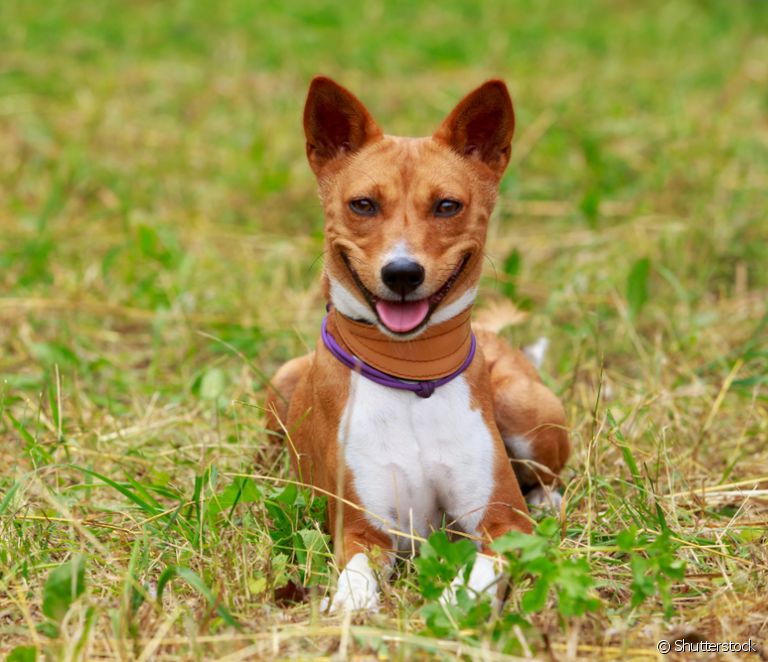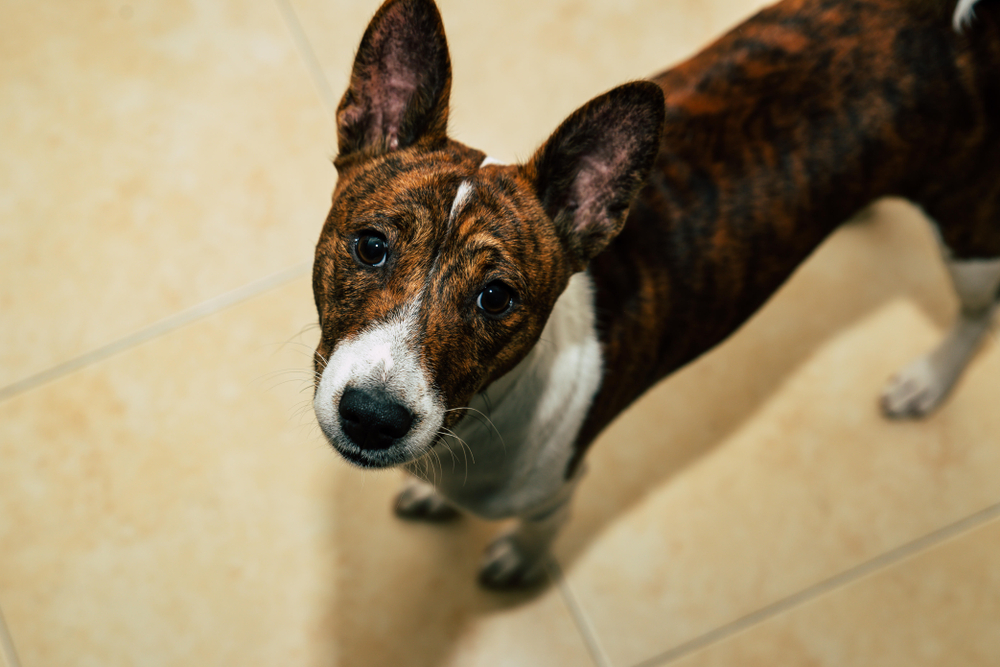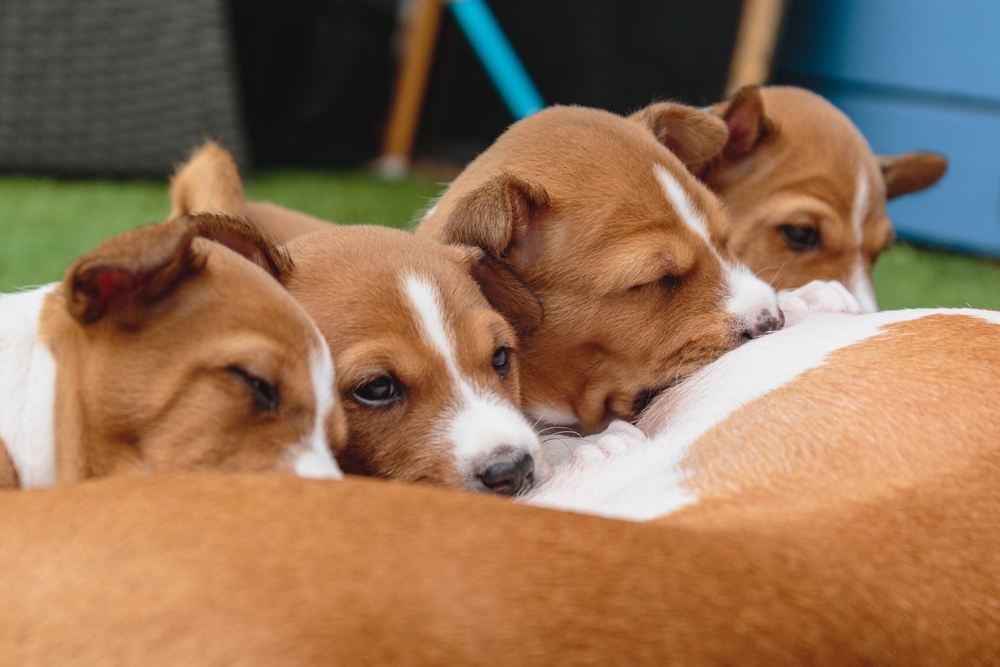Meet Basenji, a dog breed that can't bark!

Table of contents
The Basenji dog is well known for not barking. Originally from the Congo, these dogs have been part of different civilizations in the region. In ancient Egypt, Basenjis were considered sacred dogs, so drawings of the animal are still found in Egyptian tombs. This is one of the oldest dog breeds in the world, with records proving its existence for more than 4 years.A thousand years. Incredible, isn't it?
The Basenji is a medium-sized dog with a high level of cuteness. In addition, it is a breed of unique behavior, which is very affectionate with its guardians and more shy with strangers. We have gathered everything you need to know about the Basenji breed for you to learn more about these cuties.
Basenji dog x-ray
- Origin : Democratic Republic of Congo
- Group : Spitz and primitive type dogs
- Coat : short, shiny and thin
- Colors : black, red, brown or brindle (always bicolor with white or tricolor)
- Personality : affectionate, curious, intelligent, confident and energetic
- Height : 38 to 43 cm
- Weight : 9 to 12 kg
- Life expectancy : 10 to 12 years
Learn about the origin of Basenji
Many people think that the Basenji is an Egyptian dog and even refer to it as the "dog of Egypt", but that's not quite true. The breed actually comes from Central Africa and originates in the Democratic Republic of Congo. The Basenji is one of the oldest dogs in existence, with records dating back more than 4,000 years. Therefore, it already existed in Ancient Egypt and was highly acclaimed by the pharaohs. For thisreason, it ended up being "adopted" as an Egyptian dog, although this is not the real origin of the breed.
Interestingly, despite having existed for so long, the Basenji dog only became known in the 19th century. At first, they were treated as semi-wild African dogs, but with easy adaptation to the domestic environment. Thus, the first specimens were taken to England in 1895. Some time later, in 1943, the breed was officially recognized by the American Kennel Club (AKC).
Basenji's physical characteristics: curled tail and athletic build are the dog's trademarks
The Basenji is a medium to small sized dog, measuring between 38 and 43 centimetres and weighing between 9 and 12 kilograms. It has an athletic, muscular and elegant body, small, rounded eyes and pointed ears that always stand upright. However, the most striking feature of the breed is the dog's tail, which is all curled up and is positioned under the animal's body.
About the coat, the Basenji is a dog with short, shiny hair and a very fine appearance. The colors are not very varied, but can include black, red, brown or brindle - and it is always bicoloured with white, which can be in greater or lesser proportion. The Basenji puppy must also, obligatorily, have white on the paws, chest and tip of the tail.
Basenji: why doesn't the breed bark?
The Basenji doesn't bark, but that doesn't mean he doesn't make any sounds! Although he doesn't bark, he does have a very distinctive howl. This is because the Basenji's larynx is shaped differently from other dogs, so that when air passes through the larynx, it makes a kind of singing sound. In addition to singing, the Basenji can also growl and make other singing sounds.dog normally.










What is the personality of the Basenji dog like?
- Coexistence
The Basenji is a dog that has a very cat-like behavior. Like felines, dogs of this breed are very curious and stubborn. They have a hunting instinct and love to track and run after smaller animals or objects. For this reason, they need an enriched environment.
The Basenji breed is also very intelligent and independent. This independence does not interfere with their companionship, loyalty and affection for their human family. It just so happens that unlike other breeds, the Basenji demonstrates this in a more reserved way. Basenjis have a protective spirit with their human family, and will do anything to protect them if they feel they are in danger, but they are not such dogsaffectionate as other breeds, it's part of their way.
Because he has a more active instinct, he usually performs very well in dog sports. Physical exercise is even super important to meet the energy needs of the Basenji breed. Otherwise, he can become a destructive dog.
- Socialization
Socialization is one of the most important care for the Basenji puppy. Naturally, this is a breed that tends to be suspicious of strangers, but it is very attached to the family. If there are children in the house, the puppy will even relate well (as long as the little ones know how to respect their space). In any case, putting him in contact with other people and animals from an early age is the most appropriate thing to doto ensure good coexistence among all.
- Training
Dog training is suitable for both puppies and adults. It takes dedication and patience in the process, because Basenjis, besides being very active, tend to lose interest in activities very quickly. Therefore, training sessions should last from five to 10 minutes and need to be very dynamic. Even though they are a little stubborn and disconnected, they learn in a practical waywith reward tactics - i.e. with rewards offered by the mentor whenever they do something right.
4 curiosities about the Basenji dog
1) Despite being a non-barking dog, the Basenji can communicate through howls and other sounds.
2) The Basenji breed is so cat-like that these little dogs can even learn to use the litter box, if they are well trained.
3) Other characteristics of the Basenji that resemble a feline are: they hate water, love to climb furniture and do a "self-cleaning" with their own tongue (the famous cat bath!).
See_also: Puppy Dummies: is the habit healthy or can it cause physical and psychological harm to the dog?4) Basenji bitches only come into heat once a year, as do most wild dogs.
Basenji puppy: how to care for and what to expect from the puppy?
A puppy always needs special attention when adapting to a new home. With Basenji this is no different. The animal should be taken to the new home at around two months, which is when breastfeeding ends and the puppy can be separated from the mother. At this time, it is important to assemble a dog trousseau with everything he needs: bed, toys, feed pots, drinking fountain,hygienic mats and basic hygiene items.
It's also the time to take Basenji to the vet for his first appointments, where he can not only get a general check-up, but also get his first doses of puppy vaccine and dewormer. Only after the puppy has completed the vaccination schedule can walks begin - another important aspect, both for socialisation and to burn off the puppy's energy.puppies.










Important Basenji routine care
- Bath Basenji: Basenji dogs have a short coat and do their own grooming by licking themselves whenever they can (another similarity to cats). For this reason, the frequency of bathing should be lower compared to other dog breeds.
- Brushing brushing the coat is very important and is recommended at least once a week. Despite having short hair, this is a basic care to avoid the accumulation of dead hair on the animal's body.
- Nails The Basenji's nails wear out quickly because it is a very agile dog, however, it is necessary to pay attention. If the owner notices that the length is hindering the pet, it is necessary to trim them.
- Teeth : The breed's teeth require attention to avoid oral problems such as tartar and plaque. It is therefore recommended to brush the dog's teeth at least two to three times a week.
- Ears To prevent them from suffering from problems such as canine otitis and other infections, Basenjis' ears should be checked weekly. To top it off, don't forget to clean the area with appropriate pet products.
Basenji: health and breed-specific care
The Basenji is not a breed that is very prone to serious diseases. Some conditions that can develop in the breed are: Fanconi syndrome, hip dysplasia and progressive retinal atrophy. Fanconi syndrome is an inherited kidney disease that usually manifests itself from the age of four. Dysplasia affects the dog's hip joints, compromising mobilityof the animal and causing a lot of pain, while progressive atrophy can leave the dog blind in the long run.
In any case, it is necessary to have a routine of consultations with the veterinarian for general evaluation of the pet's health. This is also the ideal time to ensure the reinforcement of vaccine doses and dewormers. The administration of regular antiparasitic drugs may also be necessary. Another important point is that it is essential that the puppy has a routine of physical exercises and balanced dietfor a healthier life.
Basenji puppy: price and tips for buying
Although it is not a very common breed in Brazil, there are already specialized breeders in the country. To acquire a Basenji, a puppy kennel must be chosen very carefully. It is important to choose a breeder who treats the mothers and fathers well, as well as the puppies, and follows the essential health and hygiene rules for the animals. When interested in buying any puppy in a kennel, always ask forphotos of the puppy's parents, where they live and ask for details of vaccination, deworming etc. The price of a Basenji puppy is between R$2,000 and R$3,000 and can vary according to the awards of its ancestors and pedigree.
Questions and answers about Basenji
Why doesn't Basenji bark?
The Basenji is unable to bark because of the shape of its larynx, which is different from other dogs, so instead of the traditional dog bark, the breed emits a grunt that resembles a howl or chirp.
What breed of dog doesn't bark?
Basenjis don't bark, but they do make other sounds. Still, other breeds that are quieter overall are the Pug, Cavalier King Charles Spaniel, Akita, SharPei, English Bulldog, Whippet and Newfoundland.
What is it like to have a Basenji?
This is an independent, curious and somewhat restless dog. He can also be stubborn and temperamental. However, for those looking for a more active and cuddly dog, the breed can be a good companion, provided he receives the right care.
How to train a Basenji?
To train a dog of this breed, the Basenji should be stimulated with positive reinforcement (treats, praise and rewards). In addition, it is important to do short training sessions to keep him interested in the activity. As they are easily understood, the sessions should be up to 10 minutes long.
See_also: Dog with red eye: 5 reasons for the problem

